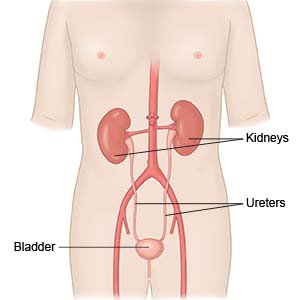Nephrostomy Tube Insertion
Medically reviewed by Drugs.com. Last updated on Apr 6, 2025.
A nephrostomy tube is a catheter (thin plastic tube) that is inserted through your skin and into your kidney. The nephrostomy tube is placed to drain urine from your kidney into a collecting bag outside your body. You may need one tube for each kidney.
 |
DISCHARGE INSTRUCTIONS:
Seek care immediately if:
- The nephrostomy tube comes out completely.
- You have blood, pus, or a bad smell coming from the place where the tube enters your skin.
- Urine is leaking around the tube 10 days after the tube was placed.
- Blood soaks through your bandage.
Call your doctor or nephrologist if:
- The skin around the nephrostomy tube is red, swollen, itches, or has a rash.
- You have a fever.
- You have low back or hip pain.
- You notice a change in how your urine looks or smells.
- A large amount of urine drains into the drainage bag over a short period of time.
- You have little or no urine draining from the nephrostomy tube.
- You have nausea or are vomiting.
- You have a black mark on your tube and it has moved.
- Your tube is longer than it was when it was put in.
- You have questions or concerns about your condition or care.
Drugs used to treat this and similar conditions
Macrobid
Macrobid (nitrofurantoin) is an antibiotic used to treat urinary tract infections. Includes side ...
Omvoh
Omvoh is used to treat moderate to severe ulcerative colitis or Crohn's disease in adults. This ...
Cipro
Cipro (ciprofloxacin) is a fluoroquinolone antibiotic used to treat bacterial infections. Learn ...
Bactrim
Bactrim (sulfamethoxazole and trimethoprim) is an antibiotic used to treat ear infections, urinary ...
Sulfamethoxazole/trimethoprim
Sulfamethoxazole/trimethoprim systemic is used for acne, bacterial infection, bacterial skin ...
Ciprofloxacin
Ciprofloxacin is an antibiotic belong to a group of drugs called fluoroquinolones. Learn about side ...
Amoxicillin
Amoxicillin is a penicillin antibiotic that fights bacteria. It is used to treat many types of ...
Amoxil
Amoxil (amoxicillin) is a penicillin antibiotic used to treat many different types of infections ...
Medicines:
- Prescription pain medicine may be given. Ask your healthcare provider how to take this medicine safely. Some prescription pain medicines contain acetaminophen. Do not take other medicines that contain acetaminophen without talking to your healthcare provider. Too much acetaminophen may cause liver damage. Prescription pain medicine may cause constipation. Ask your healthcare provider how to prevent or treat constipation.
- Take your medicine as directed. Contact your healthcare provider if you think your medicine is not helping or if you have side effects. Tell your provider if you are allergic to any medicine. Keep a list of the medicines, vitamins, and herbs you take. Include the amounts, and when and why you take them. Bring the list or the pill bottles to follow-up visits. Carry your medicine list with you in case of an emergency.
Nephrostomy tube care:
The nephrostomy tube comes out of your back, so you will not be able to care for it by yourself. Ask for help. Your healthcare provider will show you how to clean your skin, and what skin barriers and attachment devices to use. Ask what type of urinary drainage bag to use. If the bag is not single-use, ask when and how to clean it.
Prevent nephrostomy tube problems:
- Keep the tube taped to your skin and connected to a drainage bag placed below the level of your kidneys. This helps prevent urine from backing up into your kidneys. You may wear a small drainage bag strapped to your leg to let you move around more easily.
- Check the catheter to be sure it is in place after you change your clothes or do other activities. Do not wear tight clothing over the tube. Place the tubing over your thigh rather than under it when you are sitting down. Be sure that nothing is pulling on the nephrostomy tube when you move around.
- Change positions if you see little or no urine in your drainage bag. Check to see if the urine tube is twisted or bent. Be sure that you are not sitting or lying on the tube.
- Flush the tube as directed. Do this if you think the tube is blocked.
Follow up with your doctor or nephrologist as directed:
You will need to return for more tests. Write down your questions so you remember to ask them during your visits.
© Copyright Merative 2025 Information is for End User's use only and may not be sold, redistributed or otherwise used for commercial purposes.
The above information is an educational aid only. It is not intended as medical advice for individual conditions or treatments. Talk to your doctor, nurse or pharmacist before following any medical regimen to see if it is safe and effective for you.
Further information
Always consult your healthcare provider to ensure the information displayed on this page applies to your personal circumstances.
